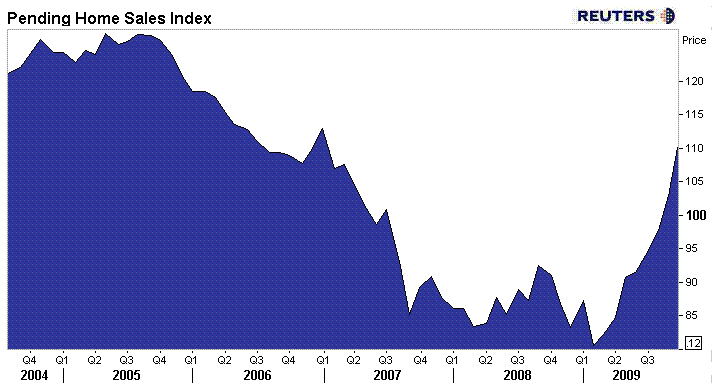The National Association of Realtors released Pending Home Sales data this morning.
Pending Home Sales, Housing Starts, and Building Permits are considered more forward looking than other housing indicators like Existing Home Sales. Existing Home Sales data is only reported at the time of closing, when the deed is transferred to the new owner whereas Pending Home Sales reports on the number of contracts that have been signed, not actual closings. Because it can take up to three months for a purchase transaction to close, Pending Home Sales data provides a more timely read on the health of housing. This problem has been more relevant in 2009 as lender turn times have slowed and other roadblocks like HVCC, new RESPA rules, and market volatility have delayed loan closings.
From the NAR....
The Pending Home Sales Index, a forward-looking indicator based on contracts signed in September, rose 6.1 percent to 110.1 from a reading of 103.8 in August, and is 21.2 percent higher than September 2008 when it stood at 90.9. The gain from a year ago is the largest annual increase on record, and the index is at the highest level since December 2006 when it was 112.8.

Lawrence Yun, NAR chief economist, said the momentum is understandable. “What we’re witnessing is a rush of first-time buyers trying to beat the expiration of the tax credit at the end of this month,” he said. “Home values will stabilize sooner rather than over-correcting. That, in turn, will mean wealth stabilization for the vast number of middle-class families and lay the foundation for a durable economic recovery.”
Regionally, the Pending Home Sales Index in the Northeast fell 2.0 percent to 83.6 in September, 6.9 percent above September 2008. In the Midwest the index rose 8.1 percent to 98.2 in September and is 17.8 percent higher than a year ago. In the South, pending home sales increased 4.9 percent to an index of 109.7 and is 22.8 percent above September 2008. In the West the index jumped 10.2 percent to 143.8 and is 23.7 percent above a year ago.
Yun added that strong near-term reports should not be overstated. “We’re clearly not out of the woods because an excess of homes remains on the market despite recent improvements,” he said. “Although current inventory is getting closer to price equilibrium, foreclosures will continue to enter the pipeline. An extended and expanded tax credit would help absorb this incoming inventory.”







